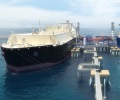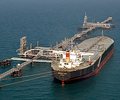
Traders diverted at least six cargoes of liquefied natural gas en route to Asia to Europe at the start of this month, due to higher European gas prices and amid weak demand in Asia, according to analysts and shipping data.
The cargo diversion could help meet additional demand from Europe as countries look to replace Russian pipeline gas after Ukraine’s transit deal expires on Jan. 1, while weather forecasts point to lower temperatures in northwest Europe.
The ships were loaded in the US and initially destined for China, South Korea, Thailand and Singapore, according to data from analytics firm Kpler. The ships then diverted in the Atlantic Ocean between January 8 and January 14, changing course towards Europe.
“This diversion is happening because prices in Asia are not premium enough to prices in Europe to attract cargoes,” said Martin Senior, head of LNG pricing at Argus, adding that almost all cargoes in the Atlantic basin are headed to Europe.
Asian spot LNG (LNG-US) has slumped for the second week in a row, as abundant inventory levels in East Asia and spot prices trading around $14 per million British thermal units (mmBtu), which are seen as too high for some buyers, limit request. Prices have fallen nearly 5% since the start of the year to $13.90/mmBtu on Friday.
The benchmark front-month contract at the Dutch TTF center (TRNLTTFMc1) closed at 47.40 euros per megawatt hour on Friday, or $14.27 per mmBtu.
The vessels Bushu Maru and Flex Vigilant, both of which contain Freeport LNG, diverted to Europe on January 8 and January 13 respectively. Flex Vigilant was originally headed to Thailand.
Grace Dahlia, chartered by Glencore GLEN, loaded at Calcasieu Pass and was first bound for China but diverted to Türkiye on 8 January.
After loading at Cameron LNG, the Mitsubishi-controlled Diamond Gas Crystal 8058 rerouted on January 13, changing its destination from South Korea to Europe. LSEG data shows the ship was headed to Rotterdam in the Netherlands.
Meanwhile, the tankers Maran Gas Sparta and Gaslog Georgetown diverted on January 10 and January 14, respectively, after loading goods at Sabine Pass. Glencore-controlled Maran Gas Sparta was heading to Singapore before turning to the Netherlands, while Cheniere Energy LNG’s Gaslog Georgetown was previously headed to China.
“We have seen more Chinese product reselling recently, they are reselling to Europe or in Asia and the second-tier countries are doing it because they don’t have as much storage capacity,” said Kpler analyst Go Katayama.
High LNG prices and weak domestic demand are preventing buyers from taking more supplies while domestic gas production and pipeline supplies from Russia are increasing year-on-year, he added.
Source: Reuters




